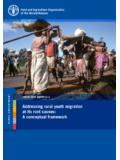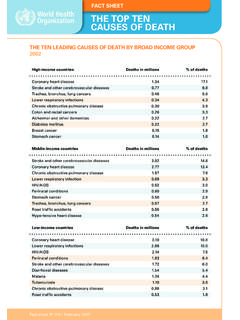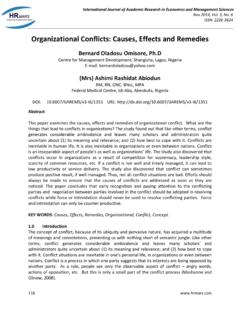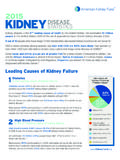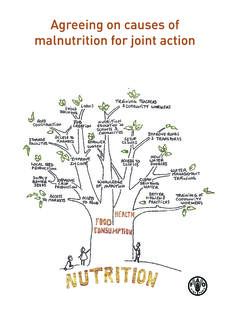Transcription of THE TOP TEN CAUSES OF DEATH - who.int
1 Fact sheet No 310 / May 2011 FACT SHEETTHE TOP TEN CAUSES OF DEATHThe 10 leading CAUSES of DEATH by broad income group,2008 High-income countriesDeaths in millions% of deathsIschaemic heart disease and other cerebrovascular disease , bronchus, lung cancers and other dementias respiratory infections obstructive pulmonary disease and rectum cancers mellitus heart disease cancer countriesDeaths in millions% of deathsIschaemic heart disease and other cerebrovascular disease obstructive pulmonary disease respiratory infections diseases traffic accidents mellitus heart disease countriesDeaths in millions% of deathsLower respiratory infections diseases heart disease and other cerebrovascular disease and low birth
2 Weight asphyxia and birth trauma infections sheet No 310 / May 2011 FACT SHEET TOP TEN CAUSES OF DEATH DEATH distribution by age and income Middle-income countries:40%45%15 %Low-income countries:17%43%40 %Deaths among people over 70 Deaths among people 15 69 Deaths among people 0 14 High-income countries:71%28%1 %WorldDeaths in millions% of deathsIschaemic heart disease and other cerebrovascular disease respiratory infections obstructive pulmonary disease diseases , bronchus, lung cancers mellitus traffic accidents SHEET TOP TEN CAUSES OF DEATH Fact sheet No 310 / May 2011 Deaths among children and adults.
3 An imbalanced picture010203040 AfricaEast ern MediterraneanSouth-East Asi aWestern Paci cEuropeAmericasHigh incomeDeaths per 1000 children aged 0 4 yearsThe figures below present estimates for six WHO regions, with the high-income countries from each region separated off as a seventh group. Regional and income groupings are defined in World Health Statistics 2011 footnotes (pages 169 170).024681012 AfricaEurope South-East AsiaEastern MediterraneanAmericasWestern Paci cHigh incomeDeaths per 1000 adults aged 15 59 yearsFact sheet No 310 / May 2011 FACT SHEET TOP TEN CAUSES OF DEATH Major CAUSES of DEATH : a primerQ: How many people die every year?
4 During 2008, an estimated 57 million people : What is the number one cause of DEATH throughout the world?Cardiovascular diseases kill more people every year than any others. In 2008, million people died from ischaemic heart disease, million from stroke or another form of cerebrovascular : Isn t smoking a top cause of DEATH ?Tobacco use is a major cause of many of the world s top killer diseases including cardiovascular disease, chronic obstructive lung disease and lung cancer. In total, tobacco use is responsible for the DEATH of almost one in 10 adults worldwide. Smoking is often the hidden cause of the disease recorded as responsible for : What are the main differences between rich and poor countries with respect to CAUSES of DEATH ?
5 In high-income countries more than two thirds of all people live beyond the age of 70 and predominantly die of chronic diseases: cardiovascular disease, chronic obstructive lung disease, cancers, diabetes or dementia. Lung infection remains the only leading infectious cause of middle-income countries, nearly half of all people live to the age of 70 and chronic diseases are the major killers, just as they are in high-income countries. Unlike in high-income countries, however, tuberculosis, HIV/AIDS and road traffic accidents also are leading CAUSES of low-income countries less than one in five of all people reach the age of 70, and more than a third of all deaths are among children under 15.
6 People predominantly die of infectious diseases: lung infections, diarrhoeal diseases, HIV/AIDS, tuberculosis, and malaria. Complications of pregnancy and childbirth together continue to be leading CAUSES of DEATH , claiming the lives of both infants and : How many young children die every year? More than 8 million deaths in 2008 were among children under five years of age, and 99% of them were in low- and middle-income countries. Why counting the dead matters Measuring how many people die each year and why they have died is one of the most important means along with gauging how various diseases and injuries are affecting the living for assessing the effectiveness of a country s health system.
7 Having those numbers helps health authorities determine whether they are focusing on the right kinds of public health actions. A country where deaths from heart disease and diabetes rapidly rise over a period of a few years, for example, has a strong interest in starting a vigorous programme to encourage lifestyles that will help prevent these illnesses. Similarly, if a country recognizes that many children are dying of malaria, but only a small portion of the health budget is dedicated to providing effective treatment, an adjustment can be countries have systems in place for assessing CAUSES of DEATH in the population.
8 Many developing countries do not have such systems, and the numbers of deaths from specific CAUSES have to be estimated from incomplete data. It is widely acknowledged that progress in this realm is crucial for improving health and reducing preventable deaths in the developing SHEET TOP TEN CAUSES OF DEATH Fact sheet No 310 / May 2011 Deaths across the globe: an overview Imagine a diverse international group of 1000 individuals representative of the women, men and children from all over the globe who died in 2008. Of those 1000 people, 159 would have come from high-income countries, 677 from middle-income countries and 163 from low-income would be the top 10 CAUSES of their deaths?
9 Low-income countries16318131310 8 8 7 5 5 4lowerrespiratoryinfectionsdiarrhoealdis easesHIV/AIDS ischaemic heart diseasemalariastroke and other cerebrovascular diseasetuber-culosispre-maturity and low birth weightbirth asphyxia and birth traumaneonatal infectionsof 1000 Middle-income countries677864936301817 161515ischaemic heart diseasestroke and other cerebro-vascular diseasechronicobstructivepulmonarydiseas e lowerrespiratoryinfectionsdiarrhoeal diseasesHIV/AIDS road tra c accidentstuber-culosisdiabetes mellitushypertensive heart diseaseof 100093 High-income countries159251497665443ischaemic heart disease stroke and othercerebrovasculardiseasetrachea, bronchus, lung cancersalzheimer and other dementiaslower respiratory infectionschronic obstructive pulmonary diseasecolon and rectum cancersdiabetesmellitushyper-tensive heart diseasebreastcancerof 1000 For more information contact: Telephone: +41 22 791 2222 WHO Media Centre E-mail: Note: In this fact sheet, we use low-, middle- and high-income categories as defined by the World Bank.
10 Countries are grouped based on their 2009 gross national income per capita. See World Health Statistics 2011 (or a more specific source reference from it) for more information.











